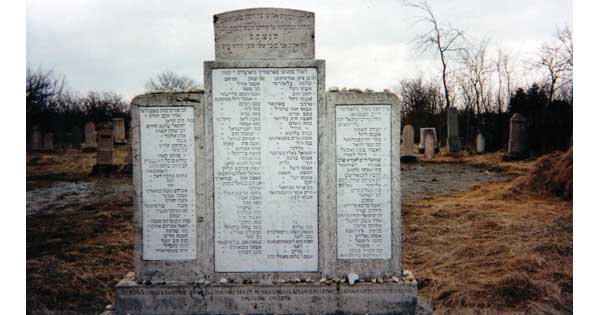
In February 2000, I traveled with my younger brother, Yehudah, to our father’s hometown of Szarvas, in Hungary, and we visited the Jewish cemetery where many of my father’s forebears are buried. In that cemetery is a monument to “our brothers from the house of Israel, the holy community of Szarvas,” murdered by the Nazis during the Second World War. The long list of names engraved on the memorial includes that of my great-grandfather Moshe Schlesinger, who died in the concentration camp of Bergen-Belsen in January 1945. There, too, are inscribed the names of two of Moshe’s sons, Mordechai Menashe and Yitzhak; his grandson Dov Mordechai Menashe; and “the boy, Mordechai Michael Yona Glausiusz,” my father’s brother, who died at the age of 21 months, also in Belsen.
My father, Gershon Glausiusz, is a survivor of Belsen. As he describes in a video recorded for London’s Brent Council, he suffered privation, deportation, starvation, disease, and the deaths of those close to him. Soldiers of the Red Army liberated him when he was 10 years old in April 1945. His father—my grandfather Israel Glausiusz—was one of only two survivors of a Hungarian slave labor battalion. My great-grandfather Jacab Glausiusz, a veteran of the Austro-Hungarian army, was deported to Auschwitz with his two sons, three daughters, and grandchildren; none of them survived the extermination camp.
Given my family’s history, my first reaction on reading a tweet by the writer Joyce Carol Oates (“Still can’t comprehend why the Danish zoo killed the beautiful young healthy giraffe. Yes, they had ‘reasons’—so did Nazi doctors.”) was incredulity. As I wrote in my column of March 19, 2014, The Death of Marius, it seemed as if she and others were more concerned about the killing of one giraffe in the Copenhagen Zoo than the colossal decline of large animals in the wild.
More disturbing is that the comparison between the zookeepers’ decision and barbaric “experiments” of Nazi doctors implies ignorance about the doctors’ crimes. So I looked up statistics on these crimes. According to Yad Vashem, the Holocaust Martyrs’ and Heroes’ Remembrance Authority in Jerusalem, 7,000 Jews, Gypsies (now called Romani), and prisoners of war were used as human guinea pigs in “brutal pseudo-scientific medical experiments” conducted in Nazi camps between 1939 and 1945. From 1933 to 1937, 200,000 young Germans purportedly suffering from genetic diseases were sterilized. The Nazis murdered an additional 200,000 mentally ill people in a “euthanasia” program.
As detailed here and here and in William L. Shirer’s book The Rise and Fall of the Third Reich, Nazi doctors at Auschwitz, Buchenwald, Ravensbrück, and other camps starved, sterilized and castrated prisoners. They injected “caustic substances” into women’s cervixes, cut out women’s ovaries, injected children with hepatitis and excised their livers, and injected chemicals into peoples’ eyes. They conducted “freezing” experiments in which people were dunked in icy water or left outside naked until they froze to death. They forced Romani to live on salt water. At Ravensbrück, hundreds of Polish women, called “rabbit girls,” were given gas gangrene wounds.
In 1947, following the trial of 23 Nazi doctors, The Nuremberg Code was drafted and later became the basis for federal regulations governing human research subjects in the United States. Among the principles detailed in the code of medical ethics: “The voluntary consent of the human subject is absolutely essential” and “the experiment should be so conducted as to avoid all unnecessary physical and mental suffering and injury.”
The memorial in Szarvas is engraved with a quotation from the Book of Lamentations: “On these I cry, my eyes, my eyes flow with tears.” My father and many relatives have shed tears over the loss of their cousins, siblings, parents, grandparents, and children. Undoubtedly, the death of a giraffe is sad. It’s also sad to see a wild animal like a giraffe spend its brief life in captivity. But before rushing to compare the zookeepers’ reasoning to the vile acts of Nazi doctors, let’s think about what the Nazis really did. And what they did was unspeakable.

